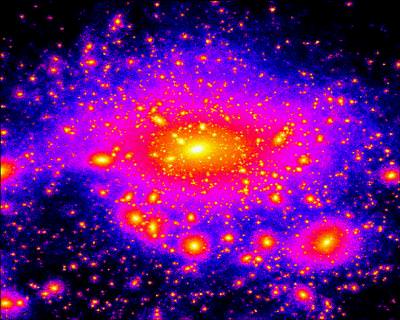New Way to Measure Curvature of Space Could Unite Gravity Theory
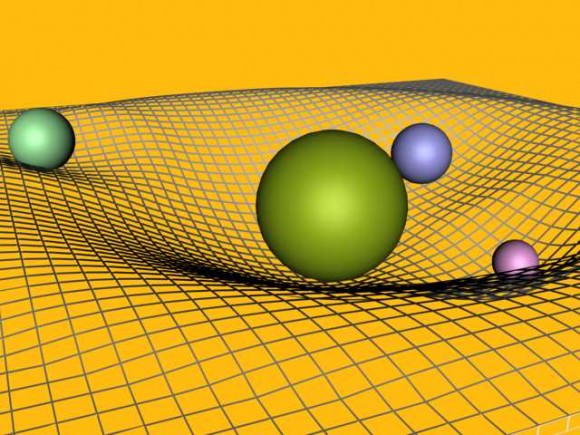
Einstein's general theory of relativity describes gravity in terms of the geometry of both space and time. Far from a source of gravity, such as a star like our sun, space is "flat" and clocks tick at their normal rate. Closer to a source of gravity, however, clocks slow down and space is curved. But measuring this curvature of space is difficult. But now scientists have used a continent-wide array of radio telescopes to make an extremely precise measurement of the curvature of space caused by the Sun's gravity. This new technique promises to contribute greatly in studying quantum physics.
(...)
Read the rest of New Way to Measure Curvature of Space Could Unite Gravity Theory (524 words)
Bareket Observatory Celebrates International Year Of Astronomy
The Bareket Observatory in Israel just did something really remarkable – they celebrated the International Year of Astronomy with a live webcast for the entire world! During the event one could listen to live explanations by a U.S. astronomer and enjoying a special musical representation to those who are blind. I had very much been enjoying my conversations with Ido Bareket and had every intention of reminding our readers when the date was going to happen so you could join in… Then the storms hit Ohio. (...)
Read the rest of Bareket Observatory Celebrates International Year Of Astronomy (376 words)
Is The Milky Way Doomed By Galactic Bombardment?
As scientists attempt to learn more about how galaxies evolve, an open question has been whether collisions with our dwarf galactic neighbors will one day tear apart the disk of the Milky Way.
That grisly fate is unlikely, a new study now suggests.
(...)
Read the rest of Is The Milky Way Doomed By Galactic Bombardment? (442 words)
NASA Science News for August 31, 2009
NASA is planning a daring new mission to investigate the Universe's favorite way of making things explode. Unlocking the secrets of "magnetic reconnection" could help alleviate the energy crisis on Earth.
FULL STORY at
http://science.nasa.gov/headlines/y2009/31aug_mms.htm?list1035898
Future Designs: Robotic Mars Greenhouse, Teleporting Fridge
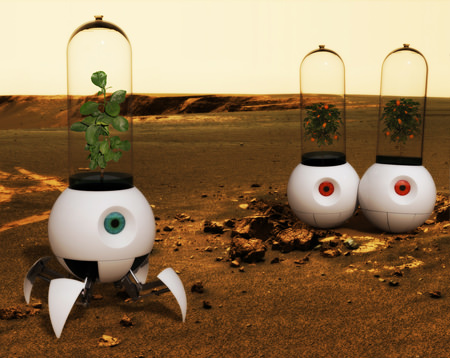
Now THIS is what I'm talking about! Every year Electrolux holds a competition for students to design concepts for future appliances, and they've just announced the eight finalists. My favs: a robotic greenhouse for Mars and a teleporting refrigerator. Le Petit Prince (Little Prince) is a robotic greenhouse concept that is specially designed to help the future exploration and expanding population when we colonize Mars. This intelligent robot carries and cares for a plant inside its glass container, which is functionally mounted on a four-legged self-transporting pod. Not only does it search for the optimum place to receive enough sunlight and other nutrients, it also send reports of its movements and developments to its fellow greenhouse robots through wireless communication. It was designed by Martin Miklica, from the Brno University of Technology in the Czech Republic. He said he was inspired by the book The Naked Sun by Isaac Asimov and R2-D2 from Star Wars (and surely Wall-E had something to do with this, too.)
See video of Le Petit Prince, below, and of the teleporting fridge.
(...)
Read the rest of Future Designs: Robotic Mars Greenhouse, Teleporting Fridge (122 words)
Loch Ness Monster On Google Earth?
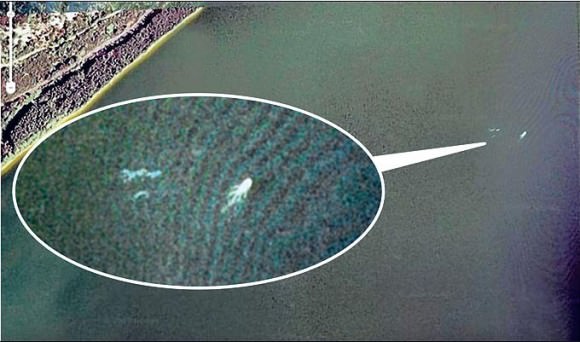
As only a British tabloid (and Fox News) could, reports came out this week of the Loch Ness Monster being spotted on Google Earth. "This amazing image on Google Earth could be the elusive proof that the Loch Ness Monster exists," The Sun reported. Well, for one thing, this doesn't look *anything* like Nessie. Doesn't he have a long black neck? And another thing about this: it looks surprisingly like a …. boat. Imagine that, a boat on a lake captured by Google Earth! Astounding! 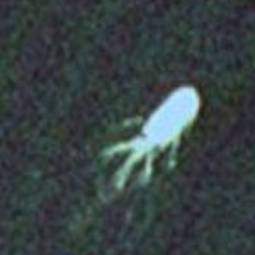 Look closely and you'll see the squared off back end of the boat (the stern), the rounded
Look closely and you'll see the squared off back end of the boat (the stern), the rounded stern bow in front, and the tentacle-looking things are just the boat's wake. This looks very much like another image of a boat on Loch Ness on Bing (below). Click on the picture to get to the image on Bing and zoom out for the full effect.
(...)
Read the rest of Loch Ness Monster On Google Earth? (53 words)
Mars Reconnissance Orbiter Goes Into Safe Mode Again

NASA's Mars Reconnaissance Orbiter put itself into a safe mode Wednesday morning, Aug. 26, for the fourth time this year. While in safe mode, the spacecraft can communicate normally with Earth, but aborts its scheduled activities, and awaits further instructions from ground controllers. "We hope to gain a better understanding of what is triggering these events and then have the spacecraft safely resume its study of Mars by next week," said MRO Project Manager Jim Erickson.
(...)
Read the rest of Mars Reconnissance Orbiter Goes Into Safe Mode Again (162 words)
LookUP to Find Astronomical Objects
Have you heard about LookUP? Stuart Lowe from the Jodrell Bank Centre for Astrophysics created this web tool to provide quick access to information about the the position and other details of specific astronomical objects. Instead of having to go search through an astronomical database, all you have to do is type in the name of the object (this doesn't apply for spacecraft) and LookUP contacts the relevant astronomical databases for you and provides info such as right ascension and declination. There's also mobile version, an application for iPhones, and a widget for your desktop. The newest tool will thrill all the astronomy Twitterers out there. Rob Simpson from Orbiting Frog fame created a Twitter account for LookUP. All you do is send a tweet to it with the name of your object, and it will send you the info and a link with for further information. For example, I wanted to know where Asteroid Apophis was, and LookUp Tweeted back: Apophis is at RA 10:35:13.594 dec 07:37:40.210 More info http://bit.ly/1aVqzG (that is valid for the time I sent the Tweet.) Check it out; it's all very quick and easy and wonderful for all you stargazers out there.
The Universe DVD Giveaway

In case you haven't heard, Season 4 of the History Channel's "The Universe" has begun. To help celebrate, they've generously offered to give away two sweet prizes related to the show. One person will get "The Universe Collector's Set", which contains Season 1, Season 2, and the 2 specials. And another person will get to choose between Season 1 on Bluray, or Season 2 on DVD.
To enter the giveaway, just email info@universetoday.com with the Subject Line: "Universe DVD Giveaway". I'll collect all the entries and pick two randomly as winners. Then I'll delete all the emails.
The deadline to enter is Monday, August 31st, 2009 at 12:00 noon (Pacific Time).
And if you want to check out The Universe now, you can buy full episodes on iTunes, order DVDs from the History Channel, and even watch it on the television. The next episode, "It Fell From Space" airs on September 1, 2009
Researchers Say Sun Cycle Alters Earth's Climate

If the energy from the sun varies by only 0.1 percent during the 11-year solar cycle, could such a small variation drive major changes in weather patterns on Earth? Yes, say researchers from the National Center for Atmospheric Research (NCAR) who used more than a century of weather observations and three powerful computer models in their study. They found subtle connections between solar cycle, the stratosphere, and the tropical Pacific Ocean that work in sync to generate periodic weather patterns that affect much of the globe. Scientists say this will help in predicting the intensity of certain climate phenomena, such as the Indian monsoon and tropical Pacific rainfall, years in advance.
(...)
Read the rest of Researchers Say Sun Cycle Alters Earth's Climate (685 words)
Fog on Titan? Help Review Mike Brown's Paper
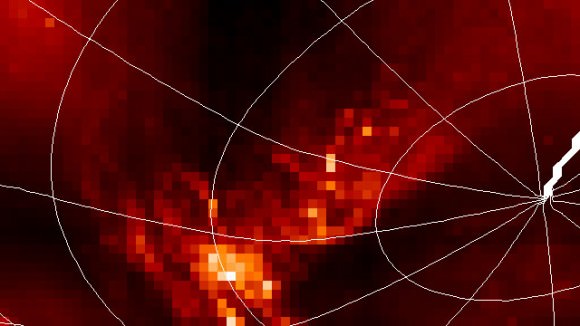
Titan is the only place in the solar system other than the earth that appears to have large quantities of liquid sitting on the surface. Granted, conditions on Titan are quite different than on Earth. For one thing, it's a lot colder on Titan and the liquids there are various types of hydrocarbons. "Methane is to Titan what water is to the earth," says astronomer Mike Brown (yes, that guy, of Pluto, Eris and Makemake fame.) But now Brown and his colleagues have discovered another similarity. Titan has fog. "All of those bright sparkly reddish white patches (shown in the image here) are fog banks hanging out at the surface in Titan's late southern summer," Brown wrote in his blog.
Wow.
(...)
Read the rest of Fog on Titan? Help Review Mike Brown's Paper (459 words)
New Images Reveal Details of the Trifid Nebula
You'll have no trouble at all enjoying these stunning new images of the Trifid Nebula. This massive star factory is so named for the dark dust bands that trisect its glowing heart, and is a rare combination of three nebula types: reflection, emission and dark nebulae. With these new images from ESO’s La Silla Observatory in northern Chile, astronomers are learning more about the early stages of stellar life, from gestation to first light.
(...)
Read the rest of New Images Reveal Details of the Trifid Nebula (416 words)
Mars Kicking Spirit When She's Down

The Spirit rover has been stuck in loose soil on Mars for several months now, and just as the rover team is preparing to execute maneuvers to attempt to free Spirit, a dust storm hits. Is Mars an unforgiving planet or what? The amount of electricity generated by the solar panels on Spirit has been declining for the past several Martian days, or sols, because of the storm, and Spirit's daily activities have been trimmed. Those watching over the rover are keeping an eye on weather reports from observations by NASA's Mars Reconnaissance Orbiter. While the rover team at JPL are keeping their "spirits" up, a recent image from the rover indicates Spirit herself might be getting frustrated with her string of bad luck:
(...)
Read the rest of Mars Kicking Spirit When She's Down (309 words)
Astro Art of the Week: Music and the Heavens
This week's featured Astro Art was created by Universe Today reader Bhavya Mittal. Bhavya calls it "Music combines the soul and the heavens," and explains the image: "On the bottom left is the most dangerous black hole identified till now. On the top right is the Crab Nebula, and below it, as you can see, is our dear Solar System. This image shows that when you are totally engrossed in music,you really get the feel of the Universe. At least I have felt it!"
(...)
Read the rest of Astro Art of the Week: Music and the Heavens (74 words)
Help Solve the Mystery of Epsilon Aurigae with Citizen Sky
We've written about Epsilon Aurigae before, but this mysterious star is just now beginning to dim, so we wanted to remind everyone that they can be involved in real science and help solve a mystery! The variable star Epsilon Aurigae is now beginning its puzzling transformation that happens every 27 years. "That means the last time Epsilon Aurigae had an eclipse we were all rockin’ big hair and sporting shoulder pads in all of our clothes," said Rebecca Turner, coordinator for a special project for the IYA organized by the American Association of Variable Star Observers (AAVSO). Astronomers can't figure out why this mysterious star dims on a regular basis, so to help solve the mystery they are calling for assistance from thousands of citizen scientists.
That means you can help contribute to real astronomical research!
(...)
Read the rest of Help Solve the Mystery of Epsilon Aurigae with Citizen Sky (679 words)

